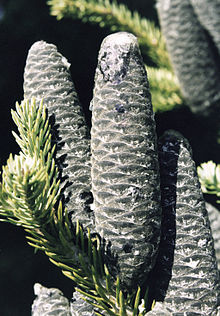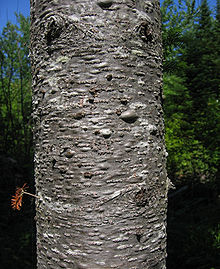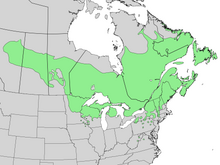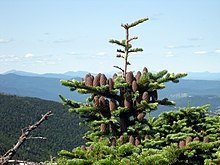Balsam fir
| Balsam fir | ||||||||||||
|---|---|---|---|---|---|---|---|---|---|---|---|---|

Balsam fir ( Abies balsamea ) |
||||||||||||
| Systematics | ||||||||||||
|
||||||||||||
| Scientific name | ||||||||||||
| Abies balsamea | ||||||||||||
| ( L. ) Mill. |
The balsam fir ( Abies balsamea ) is a species of the fir ( Abies ) genus . It grows in northeastern North America, where it inhabits both lowlands and mountains. It is considered relatively undemanding to the location and is frost hardy. In many parts of the natural range it represents the climax tree species.
The balsam fir can live up to 245 years and is therefore relatively short-lived. The needles and the resin give off an aromatic scent, which the epithet balsamea refers to for 'fragrant'.
Only wood is of economic importance today. In the past, Canada balsam was obtained from the resin bubbles of the young trees , which served as an adhesive substance in optical devices and as an embedding agent for microscopic specimens. More recently, however, the Canada balsam has been replaced more and more by synthetic materials. The balsam fir is the provincial tree and thus a kind of symbol of the Canadian province of New Brunswick .
description
Manifestation
The balsam fir grows as an evergreen tree and reaches heights of 12 to 23, rarely up to 30 meters and chest height diameters of 10 to 60, rarely up to 120 centimeters. It forms a symmetrical, pyramidal crown that tapers to a point. The crown is formed from the regular and dense whorls from four to six branches of the monopodial branched trunk. Free-standing trees are usually branched to the ground, since the branches that are deeper do not die off. The crowns of trees growing in stands are usually narrow. Young trees have a very compact, conical crown. The seedlings have at least four blunt cotyledons ( cotyledons ), which have a length of approximately 10 to 15 millimeters. Vegetative reproduction can occur especially in northern regions in humid areas .
Buds and needles
The resin- covered buds are rounded or egg-shaped and between 3 and 7 millimeters long. The bud scales are dark orange-green to reddish in color.
The narrow, linear needles are flat and 10 to 35 millimeters long. The tip of the needle is rounded or blunt. Needles of the upper crown area exposed to direct sunlight are 10 to 15 millimeters long and thicker. They are curved towards the branch axis and have a sharp needle point. All needles are colored dark green on the top of the needle and have two silvery-white stoma stripes on the bottom of the needle . Needles, which grow on branches close to the trunk, are parted in a comb-shaped manner due to a rotation at the base. The resinous needles smell strongly aromatic when rubbed. They remain on the tree for 7 to 10 years, rarely up to 13 years.
Flowers, cones and seeds
The balsam fir is single-sexed ( monoecious ). She becomes manable at the age of 20 to 30, but occasionally trees as early as 15 years develop cones . The flowering period extends from the end of April to the beginning of June, depending on the location. The flower buds form on the needle axes of previous year's branches. The 3 to 6 millimeters long, male cones are oblong-cylindrical. Their color ranges from red to purple, bluish, greenish to orange. They stand in small groups on the undersides of the branches in the central crown area. The sessile, female cones are spherical to ovoid. They are around 2 centimeters long and 1.5 to 3.75 centimeters in diameter. Their color ranges from blue-gray-green to purple. They stand in small groups on the top of the branch in the upper crown area. The yellow pollen reaches a diameter of around 90 micrometers.
The cones 3.5 to 10 centimeters long and 2 to 5 centimeters thick are gray-brown in color and have a reddish tone. The upright cones are elongated-cylindrical in shape and have a rounded tip. The cone scales are about 1 to 1.5 centimeters long and 0.7 to 1.7 centimeters wide and cover, with the exception of the phanerolepis variety , the cover scales. There are two seeds under each seed scale . Usually from the end of August to the beginning of September they begin to detach from the tenon spindle together with the tenon scales. The tenon spindles remain on the tree until the following summer.
The triangular, shiny brown seeds are 5 to 7 millimeters long and 2 to 3 millimeters wide. They have a relatively broad, purple-brown wing that is about twice as long as the seed body itself. A cone contains an average of 134 seeds. The thousand grain weight is around 7.61 grams. The seed is spread by the wind ( anemochory ) and by rodents. When the wind spreads, they can cover distances of up to 150 meters. Sufficient soil moisture is more important for the seeds to germinate than good lighting.
Root system
The balsam fir is a shallow root and therefore very susceptible to windthrow and broken roots. The roots do not grow deeper than 60 to 75 centimeters even in deep locations. A root depth of 137 centimeters has only been proven for sandy soils in northern Ontario . Rarely to form a taproot , but mostly dies after a short time. The fine roots form a dense cushion in the near-surface and humus-rich soil layers. It is not uncommon for roots to grow together with neighboring trees.
bark
Young shoots are initially hairy and later glabrous. The color of the twig bark is gray-brown. Usually small, round scars can be seen, which are caused by needles that have fallen off. Seedlings have a thin and smooth bark that is dull gray-green in color. Young trees have smooth, gray-brown bark. Resin bubbles are often formed from which Canada balsam can be obtained. Old trees develop a thick, smooth, or cracked bark that is gray to reddish brown in color. This bark is relatively thin and usually only reaches a thickness of 2.5 to 11 millimeters.
Wood
The wood of the balsam fir has a creamy white to light brown color. The heartwood cannot be distinguished from the sapwood in terms of color . If it is exposed to the elements, it turns light gray. The annual rings are clearly visible and two-thirds consist of early wood . The single-row rays are very narrow and the parenchyma is difficult to see. There are no resin channels . The tracheids reach a length of about 3.5 millimeters and a diameter of 30 to 50 micrometers. There are often small swellings at the base of the branches. With a straight and parallel grain, the wood is softer and lighter than that of the East American spruce species.
feature value Density (r 0 ) 0.38 g / cm³ Tensile strength perpendicular to the fiber 1.2 N / mm² Compressive strength perpendicular to the fiber 2.6 N / mm² Compressive strength parallel to the fiber 27.0 N / mm² Shear strength 2.3 N / mm² modulus of elasticity 7.2 N / mm² Volume shrinkage from green to the density of the skins 11.2%
Distribution and location
The balsam fir is found in northeastern North America. Their natural range extends from the Atlantic coast of Labrador , Newfoundland and Nova Scotia in the east to the Peace River Valley in northwest Alberta in the west. The northern limit of distribution is at the Lesser Slave Lake in the south of Alberta, although trees have also been detected near the Greater Northern Slave Lake at around 62 ° north latitude. The southern border is formed by an isolated population in Virginia . The species was and is rarely planted for forestry outside of North America.
The balsam fir is a frost-hardy tree species of boreal forests and represents the climax tree species in many parts of the distribution area . It grows preferentially in a continental climate , but has its optimum in the cool and humid regions of south-east Canada and the north-east USA with annual rainfall of 700 up to 1,100 mm. Depending on the location, the annual rainfall varies between 390 and 1,400 mm. The species can be found at altitudes of 1,900 meters, although in the summit regions it usually only grows as crooked wood . The balsam fir has hardly any demands on the ground. It occurs on sand and gravel as well as on organic layers over rock in the mountains. Compact loams are also populated in the mountainous areas and marshy areas in the lowlands. These soils usually have a powerful bearing horizon (O horizon) and a well-developed Eluvialhorizont on (E-horizon). Soil moisture is important for growth. The nutrient content of the soil and the location in the terrain only play a subordinate role. The pH of the populated soils is between 5.1 and 7.0.
ecology
Mycorrhizal partner
The balsam fir forms ectomycorrhizae with Cenococcum geophilum and the granule boletus ( Suillus granulatus ).
Socialization
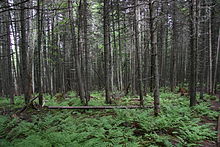
The balsam fir forms both pure and mixed stands. Mixed stands occur mainly in damp locations. In the high altitudes of the northeastern USA, almost complete pure stocks are formed. In the middle altitudes of this region as well as in the states of New Brunswick and Maine, the balsam fir is also found mixed with the American red spruce ( Picea rubens ). Furthermore, the mixed stocks can be divided into three regions:
- In the boreal zone, mixed stands are mainly formed with the paper birch ( Betula papyrifera ), the white spruce ( Picea glauca ), the black spruce ( Picea mariana ) and the American quivering aspen ( Populus tremuloides ).
- In the mountains, the balsam fir forms mainly with the red maple ( Acer rubrum ), the sugar maple ( Acer saccharum ), the yellow birch ( Betula alleghaniensis ), the paper birch ( Betula papyrifera ), the American beech ( Fagus grandifolia ) of white spruce ( Picea glauca ), the Weymouth pine ( Pinus strobus ), Populus grandidentata , the American aspen ( Populus tremuloides ), Sorbus Americana and Canadian hemlock ( Tsuga canadensis ) mixed stands.
- At locations near the coast, there are mainly red maples ( Acer rubrum ), black ash ( Fraxinus nigra ), East American larch ( Larix laricina ), white spruce ( Picea glauca ) and black spruce ( Picea mariana ) and the occidental tree of life ( Thuja occidentalis ).
The shrub layer of balsam fir woods is mostly through the Vermont maple ( Acer spicatum ), Corylus cornuta , Gaultheria hispidula , the narrow-laurel ( Kalmia angustifolia ), the Greenland Porst ( Rhododendron groenlandicum ), the Canadian yew ( Taxus canadensis ) and Viburnum lantanoides educated. Sedge species ( Carex ), Clintonia borealis , the Canadian dogwood ( Cornus canadensis ), the common thorn fern ( Dryopteris carthusiana ), the three-flowered bedstraw ( Galium triflorum ), the moss bell ( Linnaea borealis ), Maianthemum canadense dominate the herb layer plants . the cinnamon fern ( Osmunda cinnamomea ), Trientalis borealis and Trillium undulatum .
use
The wood of the balsam fir is mainly used in forestry for pulp production and as construction wood. But it is also used to manufacture cardboard, chipboard, plywood, boxes, slatted crates and wooden containers. Adhesives and paints stick particularly well to the wood. It is unsuitable as construction timber because it has only poor nail resistance and wood preservatives are difficult to penetrate. It is also prone to rot.
Due to its relatively rapid growth, the harmonious structure and the attractive needling, the species is occasionally planted as a park and garden tree. Over the years, a large number of garden forms have been bred, which are attractive for horticulture due to their special needle colors and growth forms. However, because of its sensitivity to air pollutants and road salt, it is less suitable for urban areas. The species is only suitable for windbreaks if there is sufficient soil moisture. It is widely used as a Christmas tree and Christmas wreath in the United States and Canada . Because of the aromatic scented needles, scented sachets are occasionally filled with them.
Canada balsam is obtained from the resin bubbles that appear on the trunk and astring of young trees . Canada balsam is used in the manufacture of optical instruments for attaching lenses and for pouring microscopic specimens. Today it is increasingly being replaced by synthetic materials. It is also used as a component in paints . In 2012, a research team led by Philipp Zerbe and Jörg Bohlmann described in a paper published in the Journal of Biological Chemistry the balsam fir cis- abienol , which is very similar to ambergris obtained from sperm whales . It could therefore serve as an alternative to the ambergris still used in expensive perfumes.
Diseases and pests
The balsam fir is attacked to a large extent by abiotic damaging factors. Due to the easily flammable needles and the thin, resin-rich bark, the species is particularly susceptible to forest fires. Because of the shallow root system, it is particularly at risk of wind throws on shallow sites. Root damage can already occur through stem vibrations. Crown fractures can occur from ice.
The balsam fir is often attacked by harmful fungi, with stem and root rot pathogens playing a greater role than needle parasites. The common honey fungus ( Armillaria mellea ) is the only species that causes significant losses. Stick rot is often caused by the brown cellar sponge ( Coniophora puteana ), Poria subacida , Resinicium bicolor and Tyromyces balsameus , which attack the tree via the roots and trunk injuries close to the base. An infestation increases the risk of wind throws. Furthermore, the stalked Schillerporling ( Inonotus tomentosus ), the pine-brown porling ( Phaeolus schweinitzii ), the pine-fire sponge ( Phellinus pini ) and the wild dry rot ( Serpula himantioides ) cause root diseases. The balsam fir is attacked by a variety of needle parasites, but they do not cause serious damage. The needle parasites include fungal species of the genera Lirula , Lophodermium , Phacidium , Phaeocryptopus , Pucciniastrum and Uredinopsis . The rust fungus Melampsorella caryophyllacearum , the causative agent of the pine cancer , often leads to the formation of witch brooms .
Among the insect pests, the moth choristoneura fumiferana is the most important. Its caterpillars feed on the needles and buds of the fir trees. Healthy and vigorous trees usually survive a single infestation. Repeated or extremely severe infestation in which the trees are de-needled leads to considerable growth losses and severe losses. Root damage often occurs as a result of the needling. In connection with an infestation by Choristoneura fumiferana , the so-called Stillwell's syndrome sometimes occurs , in which the needles turn bright red and the tree dies. The pine stem louse ( Adelges piceae ) , introduced from Europe, has also proven to be a pest . It sucks on the tree bark in the crown and trunk area and can lead to waste after several years of infestation. It attacks trees of all ages. The saliva of this type causes the tracheids to grow abnormally , making the wood brittle.
The seeds are eaten by mice and birds, among others. Squirrels nibble open the cones to get the seeds. Black bears ( Ursus americanus ) occasionally remove the bark from trees that are both pole and lumber age in order to get to the sweet tree sap.
Systematics
The first botanical description of this species was published in 1704 by John Ray . However, it was not given its first scientific name until 1753 with Pinus balsamea by Carl von Linné in Species Plantarum , Volume 2, p. 1002. It was placed in the genus Abies in 1768 by Philip Miller .
In the system used here, the balsam fir is placed within the genus of firs ( Abies ) in the Balsameae section and the Laterales subsection . Liu Tang-Shui 1971 put this species in the section Balsameae of the subgenus Abies . According to Franco's system , it is assigned to the Balsameae section and the Lasiocarpae series within the subgenus Sapinus .
The number of chromosomes is 2n = 24.
Varieties and forms
In the case of the balsam fir, there are hardly any comprehensive intraspecific differences, despite its large distribution area. Depending on the origin, physiological and anatomical differences in wood have been demonstrated. In the east, for example, the density of the wood is lower and the tracheid length is higher than in the west. A variety of garden forms have also been bred.
The following varieties or forms can be distinguished:
- Abies balsamea vra. balsamea : It occurs from central and eastern Canada to Virginia.
- Abies balsamea var. Phanerolepis Fern. is a variety that is believed to be a natural hybrid with the Fraser fir ( Abies fraseri ). It is recognized as a variety by only a few authors. This variety has cylindrical cones, the cover scales of which protrude. It occurs in several parts of the range, although it occurs somewhat more frequently in Nova Scotia .
- Abies balsamea f. hudsonia (Jacques) Fernald & Weath. is a not generally recognized dwarf form that occurs in New Hampshire . It grows at high altitudes and is mainly found on mountain tops.
hybrid
In the areas where the distribution areas overlap, the balsam fir forms natural hybrids with the Fraser fir ( Abies fraseri ) and the rocky mountain fir ( Abies lasiocarpa ) . There are reports from Alberta of a natural cross with Abies bifolia , which some authors regard as a subspecies of the rocky mountain fir. The hybrid produced with the Fraser fir is described by some authors as the var. Phanerolepis variety of the balsam fir. Successful attempts at crossing were made with the silver fir ( Abies alba ) and the Siberian fir ( Abies sibirica ).
Hazard and protection
In the Red List of the IUCN , the balsam fir as "not at risk" out. It is pointed out, however, that a new investigation into the endangerment of the species is necessary.
literature
- EV Bakuzis, HL Hansen: Balsam Fir . A Monographic Review. North Central Publishing Company, St. Paul, MN 1965, ISBN 0-8166-0353-7 ( books.google.at ).
- Peter Schütt : Lexicon of Conifers . Distribution - Description - Ecology - Use. The great encyclopedia [... with the participation of 30 experts]. Nikol, Hamburg 2008, ISBN 978-3-933203-80-9 , pp. 19-26 .
- Christopher J. Earle: Abies balsamea . In: The Gymnosperm Database . 2009 ( conifers.org ).
- Richard S. Hunt: Abies balsamea . In: Flora of North America . tape 2 , 1993 ( efloras.org ).
Web links
- Entry at GRIN - Taxonomy for Plants .
- Abies balsamea in the endangered Red List species the IUCN 2008. Posted by: Conifer Specialist Group, 1998. Accessed August 29 of 2010.
Individual evidence
- ↑ a b c d e f g Christopher J. Earle, 2009: Abies balsamea in The Gymnosperm Database . Retrieved August 29, 2010
- ↑ a b Schütt, Weisgerber, Schuck, Lang, Stimm, Roloff: Lexicon of conifers . Nikol, Hamburg 2008, ISBN 3-933203-80-5 , p. 20 .
- ↑ a b c d e f g Schütt, Weisgerber, Schuck, Lang, Stimm, Roloff: Lexicon of conifers . Nikol, Hamburg 2008, ISBN 3-933203-80-5 , p. 21 .
- ↑ a b c d e f g h i j k l m Robert M. Frank: Abies balsamea In: Conifers at Silvis of North America. (PDF; 5.8 MB) accessed on August 29, 2010.
- ↑ Schütt, Weisgerber, Schuck, Lang, Stimm, Roloff: Lexicon of conifers . Nikol, Hamburg 2008, ISBN 3-933203-80-5 , p. 24 .
- ^ A b c d e f E. V. Bakuzis, HL Hansen: Balsam Fir: A Monographic Review . North Central Publishing Company, St. Paul, USA 1965, p. 13-20 .
- ↑ a b Schütt, Weisgerber, Schuck, Lang, Stimm, Roloff: Lexicon of conifers . Nikol, Hamburg 2008, ISBN 3-933203-80-5 , p. 22 .
- ↑ Schütt, Weisgerber, Schuck, Lang, Stimm, Roloff: Lexicon of conifers . Nikol, Hamburg 2008, ISBN 3-933203-80-5 , p. 21-22 .
- ↑ EV Bakuzis, HL Hansen: Balsam Fir: A Monographic Review . North Central Publishing Company, St. Paul, USA 1965, p. 35-39 .
- ↑ a b c d e Schütt, Weisgerber, Schuck, Lang, Stimm, Roloff: Lexicon of conifers . Nikol, Hamburg 2008, ISBN 3-933203-80-5 , p. 23-24 .
- ↑ a b c Schütt, Weisgerber, Schuck, Lang, Stimm, Roloff: Lexicon of conifers . Nikol, Hamburg 2008, ISBN 3-933203-80-5 , p. 25 .
- ^ A b c d E. V. Bakuzis, HL Hansen: Balsam Fir: A Monographic Review . North Central Publishing Company, St. Paul, USA 1965, p. 1-9 .
- ↑ Dörte Saße: Luxury perfumes from the fir tree instead of the whale. Wissenschaft-aktuell.de, accessed on April 13, 2012 .
- ↑ a b c Schütt, Weisgerber, Schuck, Lang, Stimm, Roloff: Lexicon of conifers . Nikol, Hamburg 2008, ISBN 3-933203-80-5 , p. 24-25 .
- ↑ EV Bakuzis, HL Hansen: Balsam Fir: A Monographic Review . North Central Publishing Company, St. Paul, USA 1965, p. 120 .
- ↑ Liu Tang-Shui: A Monograph of the Genus Abies. National Taiwan University, Taipei 1971.
- ↑ a b c d Schütt, Weisgerber, Schuck, Lang, Stimm, Roloff: Lexicon of conifers . Nikol, Hamburg 2008, ISBN 3-933203-80-5 , p. 22-23 .
- ↑ a b c Rafaël Govaerts (Ed.): Abies. In: World Checklist of Selected Plant Families (WCSP) - The Board of Trustees of the Royal Botanic Gardens, Kew . Retrieved April 5, 2019.
- ↑ Entry in GRIN Taxonomy, accessed on July 10, 2010.
- ^ Entry in GRIN Taxonomy, accessed on June 6, 2010.
- ^ Entry in the IUCN Red List, accessed on August 29, 2010.


